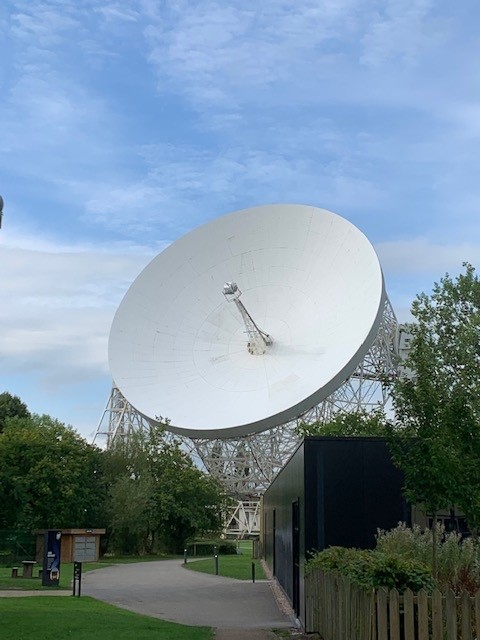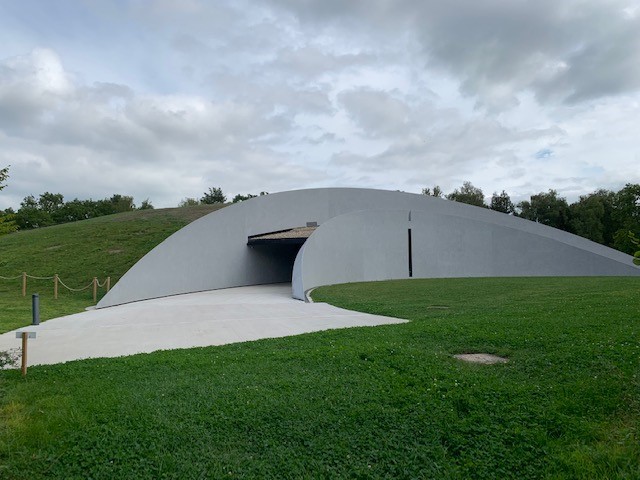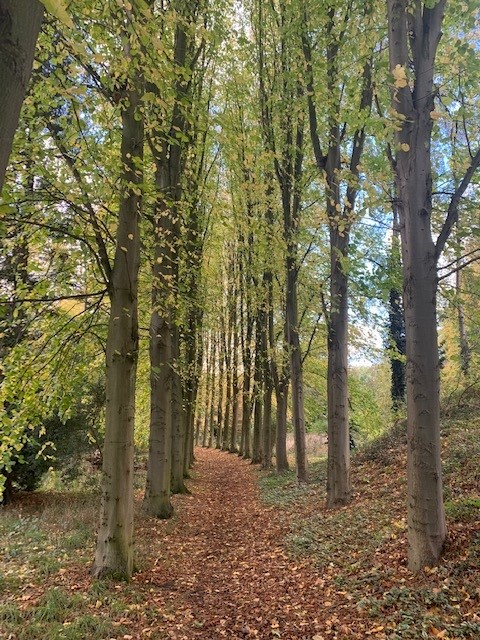An astronomical day out in rural Cheshire
2023 June 7

One of the most iconic astronomical sights in this country surely must be the Lovell Telescope at Jodrell Bank, which dominates the Cheshire Plain. At 76.2 metres (250ft) in diameter, it was the world’s largest steerable-dish radio telescope when it was first deployed in 1957. The leadership and tenacity of its founder, Sir Bernard Lovell (1913–2012), are legendary. Jodrell Bank Observatory was adopted as a UNESCO World Heritage Site in 2019.
I recently visited Jodrell’s wonderful new visitor centre, the First Light Pavilion, opened in 2022 June and built at a cost of £21 million. To say that I was impressed is an understatement! The building itself, though partially hidden under an earth mound, is the same diameter as the telescope, and is an inspiring place. With a nod to ancient sites such as Stonehenge, a slim vertical window in the centre of the building allows the Sun to shine through, forming a finger of light that moves across the entrance foyer as the day goes on and acts as a giant sundial.

The exhibition tells the story of the observatory, intertwined with the story of Sir Bernard. Whilst there is plenty to see and do for all ages, I was gratified to find that there was little of the trivialisation that has become so familiar in many other exhibition places. The story of Lovell’s research in collaboration with BAA Meteor Section Director J. P. Manning Prentice, on transient radar echoes, which they confirmed in 1946 were from ionised meteor trails, is well told. There is even an exhibit with a deck chair – Prentice’s most important observational aid, which occupied the back seat of his open-top car on every trip from Suffolk to Jodrell Bank.
In another nod to history and heritage, interactive videos are projected onto screens – some of which are actually segments of the skin of the Lovell Telescope, salvaged from an earlier refurbishment and resurfacing of the dish. All kinds of artefacts from earlier days are included, from valve-based electronics to the more mundane: typical 1950s filing cabinets where data and chart recorder traces were stored.
Elsewhere on site, there is a planetarium (the Space Dome) and a lecture room where topical talks (by real people!) are presented throughout the day. But for me, strolling around the grounds on a sunny day with a backdrop of the Lovell telescope and its smaller brethren, as well as huts from the original observatory, was equally enjoyable – with the new HQ of the Square Kilometre Array on the adjacent site pointing towards future discoveries in astronomy.
An astronomical day out in rural Cheshire need not stop at Jodrell. In the nearby hamlet of Swettenham, there is the Lovell Quinta Arboretum, lovingly built by Sir Bernard and Lady Lovell. The beautiful 28-acre site, next to their former home called the Quinta, is now owned by Tatton Garden Society. Different parts of the arboretum were planted to commemorate important events in his life. For example, Reith Avenue was planted with red-twigged limes to celebrate Sir Bernard’s BBC Reith Lectures in 1958. Nearby is St Peter’s Church, where he played the organ until very late in life.

Finally, across the fields from the observatory, in the neighbouring village of Goostrey, is the Space Invader pub, which features Sir Bernard and the Lovell Telescope on its sign – and the walls are adorned with pictures of the dish under construction. An ideal spot to end the day and contemplate the astronomical heritage of this part of Cheshire, whilst thinking about what exciting discoveries will emanate from there in the future.
| The British Astronomical Association supports amateur astronomers around the UK and the rest of the world. Find out more about the BAA or join us. |
